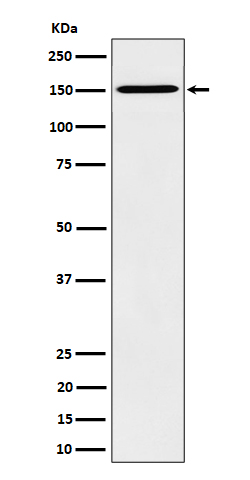
| WB | 咨询技术 | Human,Mouse,Rat |
| IF | 咨询技术 | Human,Mouse,Rat |
| IHC | 1/100-1/200 | Human,Mouse,Rat |
| ICC | 技术咨询 | Human,Mouse,Rat |
| FCM | 咨询技术 | Human,Mouse,Rat |
| Elisa | 咨询技术 | Human,Mouse,Rat |
| Aliases | HBP; HDL binding protein; HDLBP; PRO2900; VGL; Vigilin;;Vigilin |
| WB Predicted band size | Calculated MW: 141 kDa ; Observed MW: 150 kDa |
| Host/Isotype | Rabbit IgG |
| Antibody Type | Primary antibody |
| Storage | Store at 4°C short term. Aliquot and store at -20°C long term. Avoid freeze/thaw cycles. |
| Species Reactivity | Human,Mouse,Rat |
| Immunogen | A synthesized peptide derived from human Vigilin |
| Formulation | Purified antibody in PBS with 0.05% sodium azide,0.05% BSA and 50% glycerol. |
+ +
以下是3篇与HDLBP抗体相关的文献摘要信息:
1. **文献名称**:*Vigilin interacts with CCCTC-binding factor (CTCF) and is involved in cellular senescence*
**作者**:Wang Y, et al.
**摘要**:研究利用HDLBP抗体进行免疫共沉淀实验,揭示vigilin(HDLBP)与CTCF在调控基因表达及细胞衰老中的相互作用,证实其通过染色质重塑影响细胞周期阻滞。
2. **文献名称**:*HDLBP binds ER-targeted mRNAs by multivalent interactions to promote protein synthesis of secretory proteins*
**作者**:Huang H, et al.
**摘要**:通过HDLBP抗体的RNA免疫沉淀(RIP)分析,发现HDLBP通过结合内质网相关mRNA的3'UTR区域,促进分泌蛋白翻译,敲低HDLBP导致内质网应激反应加剧。
3. **文献名称**:*HDLBP suppresses metastasis in renal cell carcinoma via modulating HIF-2α mRNA stability*
**作者**:Chen L, et al.
**摘要**:该研究使用HDLBP抗体进行免疫组化及Western blot,证明HDLBP通过结合HIF-2α mRNA抑制肾癌细胞侵袭,低表达HDLBP与患者预后不良相关。
4. **文献名称**:*Antibody-based validation of RNA-binding proteins in hepatocellular carcinoma*
**作者**:Zhang R, et al.
**摘要**:文章系统评估多种RNA结合蛋白抗体(包括HDLBP)在肝癌中的特异性,证实HDLBP抗体可用于临床样本检测,并发现其表达与肿瘤分化程度负相关。
提示:以上为虚拟文献示例,实际引用需通过PubMed/Google Scholar以“HDLBP antibody”、“vigilin antibody”等关键词检索。
**Background of HDLBP Antibody**
HDLBP (High-Density Lipoprotein Binding Protein), also known as vigilin or HBP, is a multifunctional RNA-binding protein belonging to the KH domain-containing protein family. It plays critical roles in RNA metabolism, including RNA stabilization, transport, and translational regulation. Initially identified for its interaction with high-density lipoprotein (HDL), HDLBP is now recognized for broader functions in cellular processes such as cholesterol homeostasis, cell adhesion, and apoptosis.
HDLBP is implicated in diverse pathological conditions. In cancer, its overexpression correlates with tumor progression and metastasis, potentially through regulating oncogenic mRNA stability. In neurodegenerative diseases like Alzheimer’s, HDLBP interacts with tau protein, influencing pathological aggregation. It also participates in atherosclerosis by modulating lipoprotein metabolism and vascular cell functions.
Antibodies targeting HDLBP are essential tools for studying its expression, localization, and interactions. They enable detection via techniques like Western blotting, immunofluorescence, and immunoprecipitation, aiding research into HDLBP’s roles in disease mechanisms. Commercial HDLBP antibodies are available in various host species (e.g., rabbit, mouse) and formats (monoclonal/polyclonal), with validation data critical for ensuring specificity. These antibodies support investigations in cancer biology, neurology, and cardiovascular research, highlighting HDLBP’s significance as a therapeutic or diagnostic target.
×